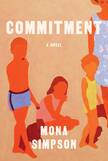Mom’s Still In Bed: Mona Simpson on family, fate and mental illness
Mona Simpson’s Commitment feints at a compelling campus class drama, then unfurls into an even more stirring cartography of the impacts of a mother’s deteriorating mental health on her three children.
At the novel’s outset in 1973, Walter Aziz is 19 and leaving their SoCal tableau for college at Berkeley, Lina is 17 and an Ivy-ambitious junior, and Donnie is an inchoate 13. All three flaunt some kind of aesthetic talent—Walter dreams of building architectural utopias; Lina draws and sculpts; Donnie can polish and thrift an unremarkable room into beauty, as their mother modeled through the many apartments of their upbringing. We learn through the children’s point of view, mostly Walter’s, that their Afghan father hails from a wealthy family but has been serially absent from their lives. We also learn that their mother Diane represents an unusual success story, as a child reared in an orphanage who still managed to put herself through college and nursing school and then begin a medical career—no small feat even for a woman of ritzier means in 1950s America.
Commitment presents the best argument for mothers going to therapy that I have ever read.
In the book’s true inciting event, Diane takes to bed and doesn’t get up—first for days, then weeks, then long enough to menace what little job and housing security the family owns, until that family has no choice but to commit her to a state-funded mental hospital. The reader recognizes Diane’s malady as catastrophic depression and prescription drug addiction, but the children of the 1970s lack this understanding or language. Also, their more urgent concern is how to prevent the electricity from being shut off, or their boarder from calling Child Protective Services. A miracle-performing family friend, Julie, steps in as guardian, but the cascading effects of Diane’s involuntary and profoundly sad resignation from head-of-household responsibilities resound throughout the novel. (Commitment presents the best argument for mothers going to therapy that I have ever read.)
The themes of Simpson’s five other novels pervade Commitment: the parents of disparate origin, the parent-child relationship and the interruptions of relationships, often by way of mental illness. The novel’s first act is permeated by Walter’s creeping recognition that his family is even poorer than he had gauged and, worse, that his mother is depending on a long-ago promise from the absent Afghans for his college future.
Walter’s character arc essentially appoints him head of the household. Never letting his dreams grow too impractical or unruly, he juggles campus jobs to send money home, then fashions himself as a real estate developer before he is old enough to drink. Lina works herself similarly raw scooping ice cream and stocking a department store, yet manages to wrest herself to Barnard, where she labors, with varying success, to be anointed a Real New York City Artist.
The novel shows a productive and healthy ambivalence about the value of a college education. (The Barnard sections pair well with a Vampire Weekend soundtrack; the Berkeley passages evoke Joni Mitchell.) Diane’s greatest pride is her education, and she is hellaciously determined to get Walter, her golden eldest, through college. The experiences of book-smart Walter provide opportunities for the author to train her critical eye on college’s incessant outlays: tuition, yes, but also application fees, housing, food, transportation, books, dating and impressing friends’ families. “The last thing he needed was to get high,” the novel’s omniscient author observes as Walter enters a skunky dorm room. “That was for kids who had nets.”
The knowledge Walter gains about these semi-obscured costs is helpful to Lina, but she still finds that her Barnard (and eventually, Columbia) admissions can’t provide a sense of belonging in those places. Her observations about the subtle, devastating textures of competition among the ambitious women she meets provide some of the novel’s most piercing insights. “She would have loved to be able to hate her mother the way they did,” Lina muses about her college friends, “with a breeziness carried by a fundamental trust in a home with a set table and dinner cooking.” This angular, acerbic prose gives the novel a sensation both sharp and hazy, not unlike youth itself.
As the two elder children struggle to penetrate the institution of the university, the novel pivots toward its larger critique: that of the institution of the state hospital. Diane’s semi-voluntary commitment to a mental institution as an adult mirrors her involuntary institutionalization in an orphanage as a child, and this history seems to inform how totally she reassimilates into institutional living. A kindly, erudite psychiatrist—who Walter hopes will cure and then marry his mother—tells the children Diane should improve within a year of what they call “moral treatment...a period of slowed-down life to take apart the patient’s system of habits and to learn new ones.” Diane, though, sinks into hypermedicated lassitude and languishes distantly, increasingly less and less verbal, weeding silently in the hospital garden, remaining an inpatient for years.
The novel’s most stirring motif permeates each child’s fear that their mother’s mental illness amounts to a ticking time bomb within them: Diane, too, was bright and upwardly mobile early in life. The novel’s action could rightly be described as charting how correct each child is about such a fate.
More than any other question, Commitment asks: Do any of us know our mothers as whole human beings?
Each child lives out a different response to this institutionalized structure. Walter learns that the primary contribution he can make to the family is not presence but breadwinning. Lina designs a large-scale project based on research into the compassionate practices of ancient Islamic treatment centers for mental illness, which seem the phenomenological opposite of her mother’s Protestant-inflected “moral treatment.” Young Donnie, unfortunately, suffers both the bulk of Diane’s psychological bequest and the underdeveloped fate of most of fiction’s youngest siblings. Withdrawn, depressed dependents are hard to vivify as characters, and he emerges only phantasmically—in the narrative as in the family, an appendage of his mother and siblings.
Switching between the perspectives of Walter and Lina (and occasionally Donnie), the novel suffers from some unevenness in the development of those characters. The reader may find it a heartbreaking and powerful narrative choice, for example, to portray a mother’s psychosomatic retreat through the eyes and experiences of her children. It is also a choice that risks denying a neurodivergent character maturity, agency and dimensionality. Diane does not narrate her own experience, and we know of her only what her children know.
However, like Lina Aziz, the character who most strongly resembles her author’s autobiography, Mona Simpson is not to be underestimated. Commitment’s structure and dramatis personae, in the final analysis, force the reader to confront some of literature’s most essential questions: Do we choose our perception by the world? What parts of living can we choose, and what fates are prewritten? “You shouldn’t have to be exceptional or even lucky to live a good life,” Walter observes, and in doing so, asks two more questions: What is a good life, and who gets one?
More than any other question, though, Commitment asks: Do any of us know our mothers as whole human beings? After hundreds of pages of Diane’s silence, I cried at one narrative starburst: Lina brings a good man home to meet her mother in the hospital, and lifted in his arms, Diane dances atop his feet. In images like this, Simpson induces a lump in the throat by suggesting another question: Are any of our lives meant to be regarded whole, or does their greatest worth consist of flinty, fleeting moments of connection, stubborn flowers and sudden laughter?
This article also appeared in print, under the headline “Mom’s Still In Bed,” in the July and August 2023, issue.











